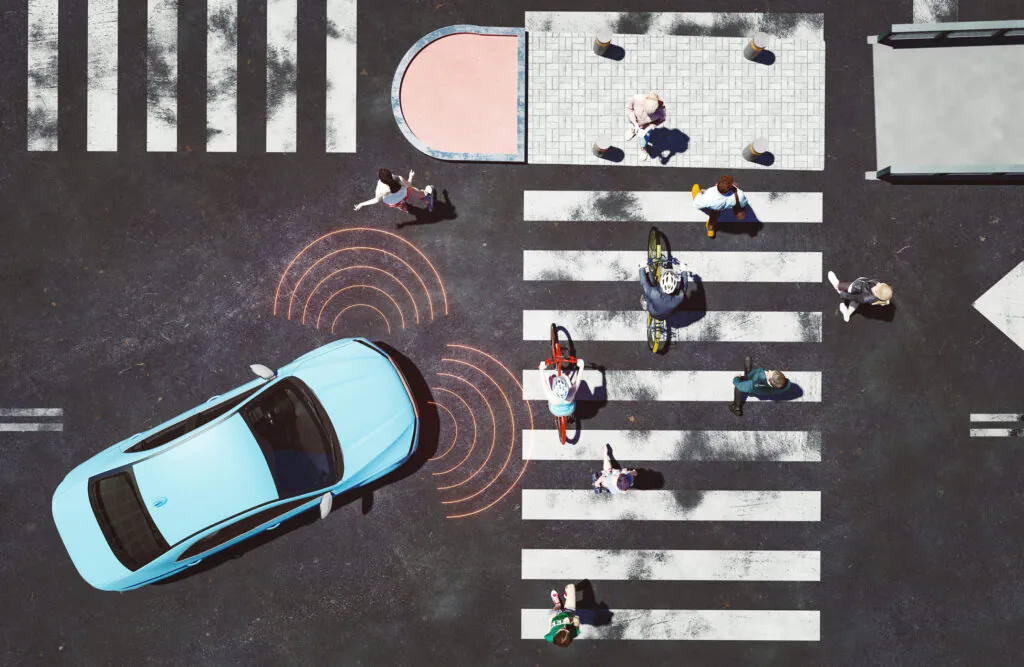What is Lidar Technology?
Lidar (Light Detection and Ranging) technology is essential in autonomous vehicles, using laser pulses to create detailed 3D maps of the environment, enabling precise navigation and obstacle detection. It offers high-resolution data, accuracy, and a 360-degree view, making it indispensable for safe driving. Despite challenges like high costs and sensitivity to weather, advancements are making Lidar more viable. The global automotive Lidar market is growing rapidly, driven by the increasing adoption of autonomous and Advanced Driver Assistance Systems (ADAS).

A Brief History of Lidar Solutions
1960: The first laser is demonstrated by Theodore Maiman at Hughes Research Laboratories.
1961: Hughes Aircraft Company develops the first prototype Lidar system.
1971: NASA uses Lidar technology in the Apollo 15 mission for lunar surface mapping.
1970s: Development of solid-state Lidar, making systems smaller, cheaper, and more reliable.
1984: Optech launches the LARSEN 500, the first operational Lidar bathymeter.
1980s: DARPA funds the Autonomous Land Vehicle (ALV) project, employing early Lidar for off-road navigation.
1990s: Lidar technology advances with improved accuracy and portability, becoming more field-ready.
2005: DARPA Grand Challenge sees the use of Lidar in autonomous vehicles, significantly advancing the technology.
2009: Google begins its self-driving car project, heavily relying on Lidar for navigation and obstacle detection.
2012: Velodyne introduces the HDL-32E, a compact and high-resolution Lidar sensor.
2016: Uber and other companies start testing autonomous vehicles equipped with Lidar on public roads.
2020: Solid-state Lidar becomes more prevalent, offering lower costs and higher reliability.
Market Drivers
Market Drivers
- Growth and Technological Advancements
- Enhanced Perception through Sensor Fusion
- Regulatory and Consumer Demand Influences
- Supporting Factors and Future Integration
Growth and Technological Advancements
The market for Lidar in autonomous vehicles is experiencing rapid growth, driven by the increasing adoption of autonomous driving technologies and Advanced Driver Assistance Systems (ADAS). Technological advancements, such as enhanced resolution and range, along with the shift towards solid-state Lidar, are making these systems more accessible and cost-effective, further fueling market expansion.
Enhanced Perception through Sensor Fusion
Sensor fusion, which involves the integration of Lidar with other sensors like cameras and radar, is significantly enhancing the perception capabilities of autonomous systems. This combination allows for more accurate and reliable detection and interpretation of the vehicle’s surroundings, improving overall safety and performance.
Regulatory and Consumer Demand Influences
Stricter safety regulations and government mandates are fostering the demand for Lidar-equipped vehicles, as these technologies are essential for meeting new safety standards. Additionally, rising consumer demand for enhanced safety features and autonomous driving capabilities is playing a significant role in the market’s growth, as more consumers seek out vehicles equipped with the latest technologies.
Supporting Factors and Future Integration
Supporting factors such as rising consumer awareness and continuous technological advancements are contributing to the increasing integration of Lidar into mainstream automotive applications. As the market evolves, Lidar technology is expected to become even more integral to the development of safe and efficient autonomous vehicles, solidifying its role in the future of transportation.
Technological Advancements
The Lidar market for autonomous vehicles is witnessing several exciting technological advancements. One significant trend is the development of solid-state Lidar systems, which are more compact, cost-effective, and reliable compared to traditional mechanical Lidar. These systems use technologies like MEMS (Micro-Electro-Mechanical Systems), optical phased arrays, and flash Lidar to improve performance and reduce costs. Another key advancement is the integration of Lidar with other sensors such as cameras and radar, enhancing the overall perception capabilities of autonomous vehicles through sensor fusion.
Additionally, there is a growing focus on Lidar system-on-chip (SoC) solutions, which integrate multiple functionalities into a single chip, reducing size and power consumption while improving performance. The market is also seeing innovations in beam steering technologies, with semi-solid or hybrid mechanical systems gaining traction for their reliability and cost-effectiveness. These advancements are driving the adoption of Lidar in the automotive industry, making it a critical component for the future of autonomous driving.
Regulations
In the United States, the National Highway Traffic Safety Administration (NHTSA) plays a significant role in regulating autonomous vehicles, including those equipped with Lidar. The NHTSA has issued guidelines and safety standards to ensure that autonomous vehicles meet specific safety criteria before they can be deployed on public roads. Additionally, the House Subcommittee on Innovation, Data, and Commerce has been working on legislation to create a national framework for autonomous vehicles, addressing safety, mobility, and data privacy concerns.
Globally, various countries have their own regulations. For instance, the European Union has established guidelines under the General Safety Regulation, which includes requirements for advanced driver assistance systems (ADAS) and automated driving systems. These regulations aim to harmonize safety standards across member states, ensuring that autonomous vehicles, including those using Lidar, are safe for public use.
Challenges
High Costs
Lidar systems are expensive, which limits their widespread adoption in the automotive industry, especially for mass-market vehicles where cost efficiency is crucial.
Weather Sensitivity
Lidar performance can be significantly affected by adverse weather conditions like heavy rain, fog, or snow, which can interfere with laser signals and reduce accuracy.
Data Processing
Real-time analysis of Lidar data requires substantial computational power and advanced algorithms, posing challenges for efficient processing and integration into vehicle systems.
Regulatory Hurdles
Varying regulations across different countries complicate market entry and standardization, making it challenging for manufacturers to ensure compliance and streamline deployment globally.
High Costs
Lidar systems are currently quite expensive, which poses a significant barrier to their widespread adoption in the automotive industry. This is particularly challenging for mass-market vehicles, where cost efficiency is a critical factor. The high costs are primarily due to the advanced technology and precision manufacturing required for Lidar sensors. As a result, many manufacturers are focusing on reducing costs through technological innovations and economies of scale to make Lidar more accessible for broader use.
Weather Sensitivity
Lidar performance can be significantly impacted by adverse weather conditions such as heavy rain, fog, or snow. These conditions can interfere with the laser signals emitted by Lidar sensors, leading to reduced accuracy and reliability. For instance, rain droplets or snowflakes can scatter the laser beams, causing false readings or signal loss. This weather sensitivity poses a challenge for the consistent performance of autonomous vehicles, necessitating the development of more robust Lidar systems or complementary technologies to mitigate these effects.
Data Processing
The real-time analysis of Lidar data requires substantial computational power and sophisticated algorithms. Lidar generates a large amount of high-resolution data that needs to be processed quickly to make real-time driving decisions. This demands advanced hardware and software solutions capable of handling the data efficiently. The integration of Lidar data with other sensor inputs, such as cameras and radar, further complicates the processing requirements, making it a significant challenge for the seamless operation of autonomous vehicles.
Regulatory Hurdles
The regulatory landscape for autonomous vehicles and Lidar technology varies significantly across different countries. This variation complicates market entry and standardization efforts for manufacturers. Each country may have different safety standards, testing requirements, and approval processes, making it challenging for companies to ensure compliance and streamline deployment globally. Navigating these regulatory hurdles requires substantial resources and strategic planning to adapt to the diverse regulatory environments and achieve widespread adoption.
Case Study: Waymo’s Use of Lidar Technology in Autonomous Vehicles
Background
Waymo, a subsidiary of Alphabet Inc., has been at the forefront of autonomous vehicle technology. Since its inception, Waymo has focused on developing self-driving cars that can navigate safely and efficiently in various environments. A key component of their technology stack is Lidar (Light Detection and Ranging), which provides high-resolution 3D mapping and obstacle detection.
Challenge
One of the primary challenges in developing autonomous vehicles is ensuring safety and reliability in diverse and complex driving conditions. Traditional sensors like cameras and radar have limitations, particularly in low light or adverse weather conditions. Waymo needed a solution that could offer precise, real-time environmental mapping to detect and react to objects, pedestrians, and other vehicles accurately.
Solution
Waymo integrated advanced Lidar systems into their autonomous vehicles. These Lidar sensors emit laser pulses that bounce off objects and return to the sensor, creating detailed 3D maps of the surroundings. This technology allows the vehicle to “see” its environment with high accuracy, even in challenging conditions. The Lidar system works in conjunction with other sensors, such as cameras and radar, to provide a comprehensive perception of the vehicle’s surroundings.
Implementation
Waymo’s Lidar-equipped vehicles underwent extensive testing in various cities, including complex urban environments. The company focused on refining the Lidar technology to ensure it could handle real-world scenarios, such as detecting small objects, navigating through traffic, and responding to unexpected obstacles.
Results
The integration of Lidar technology significantly improved the safety and reliability of Waymo’s autonomous vehicles. The high-resolution 3D maps enabled precise navigation and obstacle detection, reducing the likelihood of accidents. Waymo’s vehicles successfully navigated millions of miles on public roads, demonstrating the practical benefits of Lidar in enhancing autonomous driving. The technology allowed the cars to operate safely in diverse conditions, from bright daylight to low-light environments, showcasing its versatility and effectiveness.
Conclusion
Lidar technology has become a cornerstone in the development of autonomous vehicles, offering unparalleled precision in navigation and obstacle detection through high-resolution 3D mapping. Despite challenges such as high costs, weather sensitivity, and the need for substantial data processing power, continuous advancements are making Lidar more viable and cost-effective. The global automotive Lidar market is poised for significant growth, driven by technological innovations, stricter safety regulations, and rising consumer demand for enhanced driving experiences. As demonstrated by Waymo’s successful integration of Lidar, this technology is crucial for ensuring the safety and reliability of autonomous vehicles, paving the way for a future where self-driving cars are a common reality on our roads.


